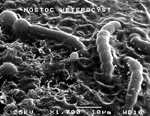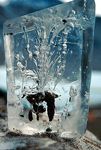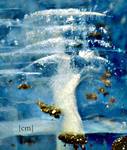February
18, 2001
Uncovering
Life in the "Valley of the Dead"
Rugged
Antarctic researchers unveil a complex ecosystem of microbes in the
ice cover of an Antarctic lake, and discover how the organisms' survival
may depend on -- of all things -- dirt and bubbles.
by Mike Matz
|

At
-30° Celsius, Priscu's team cuts into Antarctic ice, looking
for signs of life.
|
Montana
State biologist John Priscu probably gets a better workout doing his
job than the average scientist does.
In temperatures
that rarely topped -50° C, he and his colleagues recently spent
three weeks using chainsaws (without oil) to slice deep into the thick
ice cover of Bonney Lake in Antarctica. As the ice hole grew deeper,
they had to use special blowers to expel the exhaust and supply fresh
air to the fatigued saw handlers.
But
the grueling labor paid off. Close inspection of Bonney's icy interior
revealed both the presence of microbe colonies and important clues
as to how these colonies survive -- discoveries that boost our rapidly
expanding knowledge of Antarctic life in a place recently thought
to be completely lifeless.
McMurdo
Dry Valleys: An Alien Landscape
Bonney
Lake is found in a desert region of Antarctica called the
McMurdo
Dry Valleys, the largest area of non-ice-covered land in Antarctica
(about 4,000 square kilometers). But the region is also home to some
of the world's only permanently ice-covered lakes, including Bonney.
With an average air temperature of less than -20° C and annual
precipitation of six centimeters, McMurdo is the coldest and driest
desert on the planet.
|

Coated
with a permanent ice cover, Bonney Lake is set in the bizarre
landscape of Antarctica's McMurdo Dry Valleys.
|
In the
early 1900s, when Antarctic explorer Robert Falcon Scott became the
first man to hike through McMurdo, he referred to the region in his
journals as the "valley of the dead." At the time, that must have
felt like an apt description: there were no clearly visible signs
of life in the region's otherworldly barren landscape of windswept
rock and ice-capped lakes.
For
many decades after Scott's expedition, no one offered evidence of
life to challenge his eerie description of McMurdo.
But
since 1990, pioneering Antarctic scientists have begun to find microbial
life in McMurdo's soils, lakes, and ephemeral summer streams. John
Priscu's team has been at the forefront of research looking for life
inside the icy coating of the region's permanently ice-covered lakes.
Why
look for life in ice? Ice can contain pockets of liquid water, which
is a prerequisite for life. That means the interior of the ice is
probably a wetter, warmer, and friendlier environment for life than
the cold, dry surface of the McMurdo desert.
Searching
for Life in Dirt
|

A
scanning electron micrograph of microbes found in McMurdo Dry
Valley lake ice.
|
For
Priscu, a critical clue to the existence of life in the ice covers
of McMurdo's lakes was the presence of sediment on their surfaces,
deposited by fierce winds. Observing a dirty film of sediment on the
lakes during the dark winter months but not in the light months, Priscu
recognized that the dirt must seep into the ice as the sun melts the
surface.
If microbes
existed in the sinking sediments, they could potentially survive deep
in the ice layer. The only way to find out was to extract samples
from the ice.
Using
a technique known as core sampling, which involves removing ice samples
with a specially designed drill, Priscu's team found chunks of sediment
trapped about two meters underneath the surface. Chemical and microscopic
analysis of the samples indeed revealed a complex microbial ecosystem
of many different species -- including photosynthetic microbes that
make carbon from sunlight, and bacteria that live off the carbon.
DNA studies showed that while most of these microbes seemed to be
species found in the soil above, a few species had never before been
documented by science.
Water
and Bubbles
How
did these sediment-bound creatures stay alive in the ice? Because
life depends on the presence of liquid water, Priscu now needed to
figure out how the microbes found water deep inside the ice cover.
By collecting temperature data in the ice over time, Priscu's team
discovered that as much as 35 percent of the ice was liquid in the
areas where sediments were suspended.
That
meant the sediment not only provided the microbes with nutrients and
a free ride into the ice. It was also somehow helping them get water.
To follow
up on these intriguing findings -- and explore the connections between
the sediment, the microbes, and water -- Priscu decided to cut a giant
chamber in Bonney's ice cover and expose the layer of sediment two
meters down. That's where the chainsaws and the back-straining three
weeks came in.
|

The ice cavern, which was more than three meters
deep when completed, unveiled stunning bubble patterns on the
walls.
|
"All
the work did pay off," Priscu said. "We could now look around the
sides and get the big-picture view of what's going on."
What
they saw inside the cavern was an awe-inspiring gift from nature:
covering the icy walls were beautiful spraying patterns of bubbles
fanning above clusters of sediment.
The
bubbles were not only elegant; they also painted critical insights
into the survival of life in Lake Bonney. Since bubbles form as liquid
water freezes, their presence offers more evidence that the sediment
clusters were in liquid at one point.
Deeper
analysis of the bubble shapes and spray patterns show that the clusters
were the last place to freeze. This may partly be because the bubbles
seem to act as "light pipes" for the sediment. Preliminary light studies
in Priscu's laboratory reveal that the peculiar arrangement of bubbles
seems to focus sunlight onto the sediment below, providing more light
for photosynthesis and more heat to maintain a liquid environment
longer.
|


Elegant
spraying patterns of bubbles in these lake-ice blocks offer
clues to how microbes in the sediment clusters survive deep
in the ice.
|
Beyond
Bonney
The
microbiological discoveries of Antarctic scientists like Priscu may
open scientific doors far beyond the realm of Antarctica.
For
one, the landscape of the McMurdo Dry Valleys is perhaps earth's closest
analogue to the ice-covered surface of Jupiter's moon Europa. Antarctic
researchers, for example, have noted that the visually chaotic appearance
of the ice surface on McMurdo's permanently ice-covered lakes is very
similar to what scientists think Europa's ice looks like.
Because
of these similarities, better understanding lakes such as Bonney can
provide important insights for astronomers as they seek to uncover
the geological and chemical -- and possibly even the biological --
characteristics of Europa. Our earthly research can also help us design
the tools and technology we'll need to explore this faraway moon's
surface.
Life
in McMurdo may also hold secrets to the origins of life on earth.
While some researchers believe the first organisms arose out of a
hot soup, many Antarctic scientists are looking for clues pointing
to the origins of life when earth was blanketed by ice, about 600
million years ago. During this ancient freeze -- like in present-day
Antarctica -- life was more likely to exist and evolve in the interior
of the ice than on the harsh surface.